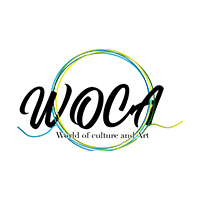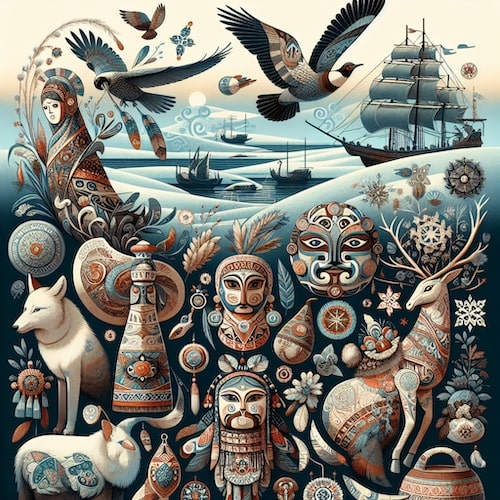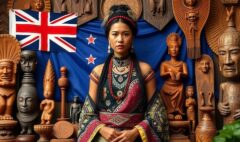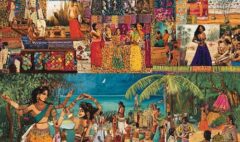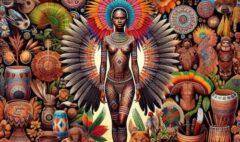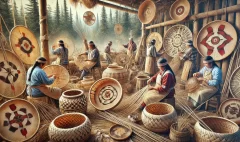Discovering the Indigenous Arts of Russia
Russia, the world’s largest country, is not only home to a vast landscape but also to an incredible diversity of indigenous cultures, each with its own unique artistic traditions. From the icy tundras of Siberia to the rolling plains of the steppes, Russia’s indigenous peoples have developed distinct art forms that reflect their deep connection to nature, spirituality, and the rhythms of their environment. Though less known globally, these art forms offer a fascinating window into the cultural richness of indigenous arts of Russia.
Indigenous Peoples of Russia: A Cultural Mosaic
Russia is home to over **180 different ethnic groups**, with more than **40 officially recognized indigenous peoples**, primarily living in the northern, eastern, and Siberian regions of the country. Among these groups are the **Saami**, **Nenets**, **Chukchi**, **Evenki**, and **Yakut (Sakha)**, to name just a few. Each of these groups has developed its own artistic traditions, often reflecting their environment, spiritual beliefs, and traditional ways of life, such as hunting, fishing, and herding reindeer.
Key Forms of Indigenous and Traditional Russian Arts
1. **Reindeer Hide Art and Clothing**
For many indigenous groups in the Russian Arctic, especially the **Nenets** and **Evenki**, reindeer are not only a source of food and transportation but also central to their artistic traditions. Reindeer hide and fur are used to craft intricate **clothing**, boots, and decorative items, often embellished with symbolic patterns passed down through generations.
The **Chukchi** people, for example, are known for their skill in making **ornate fur clothing**, which is both functional and artistic. These garments are carefully decorated with beads, fur, and appliqué patterns, reflecting the wearer’s connection to nature and their role within the community.
2. **Birch Bark Crafts**
Birch trees, which grow abundantly in the taiga forests of Siberia, provide the raw material for one of the most traditional Russian indigenous crafts: **birch bark art**. Indigenous groups such as the **Khanty** and **Mansi** have perfected the art of using birch bark to create **baskets, containers, shoes, and even cradles**. These items, though practical, are often beautifully decorated with intricate patterns and carvings, turning everyday objects into works of art.
In addition to birch bark, wood carving is a significant tradition among indigenous groups in Siberia, where craftsmen create everything from **shamanic drums** to **totem poles**, all imbued with spiritual significance.
3. **Shamanic Ritual Art**
Shamanism has long been a central spiritual practice among many indigenous groups in Russia, particularly the **Evenki**, **Yakut**, and **Buryat** peoples. Art associated with shamanism includes a variety of mediums, such as **ritual masks**, **drums**, and **figurines**. These objects are not only artistic creations but also tools used in spiritual rituals, connecting the physical and spiritual worlds.
The designs on these shamanic items often depict animals, celestial bodies, or spirits, and the creation of such art is steeped in deep ritual significance. For instance, a **shaman’s drum**, often made from reindeer hide, might feature symbolic imagery that represents a map of the universe or spiritual journey.
4. **Jewelry and Beadwork**
The **Yakut (Sakha)** people of Siberia are particularly renowned for their **silverwork** and **jewelry**. Silver holds great spiritual and symbolic value for the Yakut people, who believe it protects against evil spirits. Yakut women traditionally wore **ornate silver necklaces, earrings, and bracelets**, often passed down through generations as family heirlooms.
Beadwork is another important art form, particularly among the **Nenets** and **Evenki** women, who create stunning **decorative beadwork** for clothing, headbands, and bags. These intricate designs often tell stories about the natural world, animals, and the community’s history.
5. **Throat Singing and Performance Arts**
The indigenous peoples of Siberia, especially the **Tuvans** and **Yakuts**, have a rich tradition of **throat singing**, known as **khoomei**. This unique musical art form involves producing multiple notes simultaneously, mimicking the sounds of nature, such as the wind or flowing rivers. Throat singing is often performed during spiritual ceremonies and community gatherings, where it serves as both entertainment and a connection to the spiritual realm.
6. Storytelling and Oral Traditions
Like many indigenous cultures worldwide, the indigenous peoples of Russia have long relied on **oral storytelling** as a way to pass down history, spiritual beliefs, and cultural knowledge. Stories are often told through **epic poems**, songs, and dance, sometimes accompanied by **traditional instruments** like the **balalaika** or **jaw harp**.
In the **Sakha Republic**, for instance, the **Olonkho** is a traditional epic poem performed by master storytellers. Recognized by UNESCO as a masterpiece of the oral and intangible heritage of humanity, Olonkho performances are a powerful expression of Yakut cultural identity.
Top Indigenous Women Artists in Russia and Beyond
The role of indigenous women in Russian art is as significant as their male counterparts, often working behind the scenes to preserve and transmit traditional knowledge through their crafts.
1. Maria Varlamova (Yakut)
Maria Varlamova is a renowned **Yakut silver jeweler** and artisan. Her work preserves the ancient traditions of Yakut silversmithing, crafting intricate necklaces, earrings, and brooches that reflect her people’s deep connection to nature and spiritual beliefs. Varlamova’s jewelry is known for its detailed craftsmanship and symbolic designs, often incorporating traditional Yakut patterns that tell stories of the earth, animals, and the cosmos.
2. Ludmila Vodopyanova (Khanty)
Ludmila Vodopyanova is an **ethnographer and master of birch bark weaving** from the **Khanty** people of Siberia. She has dedicated her life to preserving the traditional craft of birch bark weaving, which has been passed down through generations in her community. Her work includes intricate baskets, shoes, and household items that are not only practical but also rich in cultural symbolism. Vodopyanova is widely respected for her efforts to teach younger generations the importance of preserving this unique art form.
3. Oksana Tsygankova (Buryat)
Oksana Tsygankova is a contemporary **Buryat artist** known for her work in **textiles and painting**. She blends traditional Buryat patterns and motifs with modern artistic techniques, creating pieces that reflect both the ancient spiritual beliefs of her people and the challenges they face in the modern world. Tsygankova’s work often explores themes of identity, memory, and the connection between people and their land.
Conclusion: The Enduring Power of Indigenous Art in Russia
The indigenous and traditional arts of Russia are not just beautiful artifacts; they are living expressions of cultural identity, spirituality, and resilience. Despite the pressures of modernization and globalization, many indigenous artists continue to practice and evolve their crafts, ensuring that their traditions remain vibrant and relevant today.
By understanding and appreciating the art of Russia’s indigenous peoples, we gain a deeper insight into their lives, beliefs, and the incredible diversity of the human experience. These art forms remind us that even in the farthest reaches of the world, creativity and culture thrive, carrying the wisdom of the past into the future.
Related Posts
The Meditative Power of Ikebana: Finding Calm Through Flower Arranging
The Captivating World of New Zealand Indigenous Arts
Exploring the Indigenous Arts of India
Discovering the Indigenous Arts of Brazil
Weaving Wonders: The Beautiful Art of Indigenous Basket Making in Canada
Search
Latest Posts
Popular Tags
